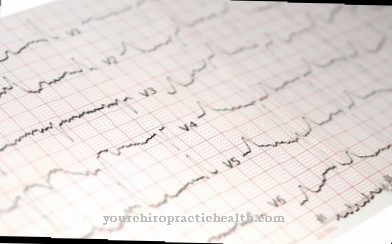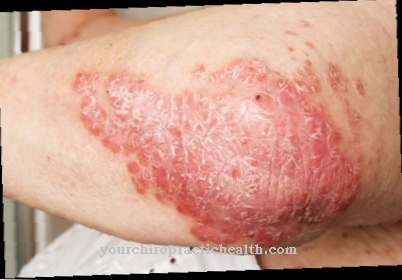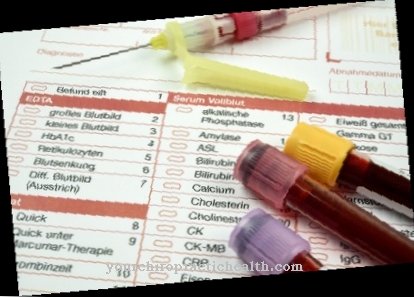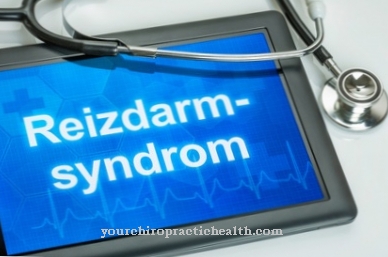The pharmacological agent Cefalexin is an antibiotic that is used to treat bacterial infections. Cefalexin can be administered orally and belongs to the antibiotic group of cephalosporins.
What is Cefalexin?
As a cephalosporin, cefalexin belongs to the so-called beta-lactams, which are industrially semi-synthetically produced. It is an antibiotic that requires a prescription in Germany. After taking a tablet with the active ingredient cefalexin, it is quickly absorbed through the mucous membranes of the gastrointestinal tract.
The half-life in the bloodstream is about 1 hour. Cefalexin also flows through the liver cells, but unlike many other antibiotics, it is not broken down or changed in its chemical structure. At the end of the half-life in the blood plasma, cefalexin is therefore completely and unmetabolized via the two kidneys with the urine.
The molecular weight of the antibiotic cefalexin is about 348 g / mol. The multipeptide cefalexin consists of the chemical elements carbon, hydrogen, nitrogen, oxygen and sulfur.
Pharmacological effect
The antibiotic is used against germs that are sensitive to cefalexin. As a so-called broad-spectrum antibiotic, Cefalexin acts against a large number of bacterial pathogens. An effect on viruses, however, is excluded.
After oral ingestion, the active ingredient is quickly distributed in all organs and tissues via the blood vessel system, so the antibiotic's effect is systemic.
Cefalexin intervenes selectively and directly in the reproduction of pathological bacteria by depositing itself in the cell wall. As a result, the cell wall synthesis of these bacteria is inhibited, which is why they can no longer divide independently and thus die. Because the cell wall of pathogenic bacteria must be intact so that the metabolism of these pathogens can function smoothly.
After its storage in the bacterial cell wall, cefalexin blocks the synthesis of peptidoglycan, but this low molecular weight protein is essential for the stability of the bacterial cell wall. The antibiotic cefalexin ensures that the structural integrity of the bacterial cell wall can no longer be achieved. The immediate consequence is the death of the bacteria in the infected areas of the body. Cefalexin works by intervening directly in the metabolism of the pathogenic bacteria.
Medical application & use
When used medicinally, the broad spectrum antibiotic cefalexin is particularly effective against so-called gram-positive bacteria. These bacterial strains include, for example, staphylococci, streptococci, coli bacteria or Klebsiella.
As a special feature, Cefalexin has an enterococcal gap that must be taken into account during treatment. Cefalexin is therefore explicitly not effective against enterococci, as their cell wall differs greatly from other gram-positive germs in terms of chemical composition.
The effect of Cefalexin relates exclusively to bacteria. It has been proven many times that cefalexin has no effect against mycoplasma, chlamydia or multi-resistant germs (MRSA).
The main areas of application for oral treatment with cefalexin are bacterial infections of the upper respiratory tract, such as tonsillitis or laryngitis. Lung infections caused by bacteria also respond well to treatment with cefalexin, as long as the active ingredient can be administered orally.
Administration of the active ingredient cefalexin by infusion is contraindicated. Other typical areas of application are bacterial otitis media, urinary tract infections caused by gram-positive bacteria and bacterial infections of the skin.
Foci of infection of the soft tissues and bones that lie deeper in the organism are generally accessible to treatment with Cefalexin. Therefore, for example, chronic inflammation of the bones, osteomyelitis, joint inflammation or phlegmon can be treated with the active ingredient.
Cefalexin diffuses into the body tissue via the bloodstream and can kill the pathogenic germs on the spot, even with chronic courses. In the case of these non-acute infections, however, particular attention must be paid to the duration of therapy and the dose in order not to endanger the success of the treatment and to effectively prevent resistance.
Risks & side effects
As with many other antibiotics, the administration of cefalexin can develop resistance. The antibiotic would then no longer work. In order to prevent bacterial resistance from developing, cefalexin should always be taken for a sufficient length of time and in an appropriate dose based on body weight.
In the case of known hypersensitivity reactions to cefalexin, the active ingredient must not be used. There may be unwanted body reactions and side effects, especially at the beginning of treatment. Most of the undesirable effects caused by Cefalexin relate to gastrointestinal disorders with symptoms such as nausea, vomiting, or diarrhea. The doctor must decide on a case-by-case basis whether the drug should be discontinued if such side effects occur.
Other known side effects are dizziness and disturbances in the electrolyte balance. If penicillin is administered at the same time, cross-resistance can also occur. During urine tests, the presence of cefalexin in the urine can temporarily falsify diagnostic values.

























.jpg)


